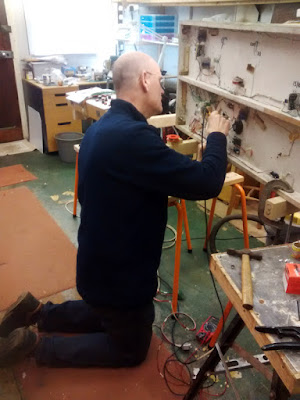Water supply ducting
Grass
Test some stock
No meeting last week due to various family commitments and no Laurence this week either.
A small amount of work was undertaken together with a lot of pottering around. Stephen progressed the water pipe ducting, staining the casing, gluing in place and adding timber supports. The installation required the removal of some gasifier fittings and the overhaul of the area floor finish by Geoff. Mid-span support (angle-iron), shrubbery and a tap on the isolator valve cupboard will be fitted next time.
Geoff also glued lots more grass strips (pre-made on silicon paper) and some much longer strands, which add some attractive variety.
Stephen wanted to test a 'new' chassis that had been misbehaving on his shelf test track at home, so power and controllers were installed, and the track given a thorough cleaning. This always throws up a few issues like sticky points and minor obstructions and is useful for 'learning' the layout.
The loco in question is an as-new, Bachmann HO GE44 off eBay. It runs well, but had a few issues with speed graduation and running when the controller was off! Stephen suspected some 'DCC ready' electronics might be to blame, but the unit ran impeccably on the ECM controller, so it's down to Stephen's £3.65 Chinese controller!
He also brought along his current project. Whilst researching a railcar to fit on an Ahearn bogie chassis, he came across a 4-w railvan that ran on the Longmoor Millitary Railway (SG).
 |
| http://railphotoprints.uk/p242188935/h64531A4B#h64531a4b |
... and the bodywork started.
Geoff and Stephen agreed that it would be nice to paint and 'brand' the vehicle in Army colours, to represent a new arrival to the railway. Whilst making this statement, we realised that although we are working on Worton Court (the station), we hadn't actually given the railway a name. An initial discussion ensued, and a few ideas were mooted (CLR, WCR, WCER), but a full compliment of directors obviously need to discuss the matter in more detail.
The railvan chassis is slightly shorter, more sturdy than the one below and has twin flywheels. In due course, this chassis will provide the base for a railcar. For £20 each, both run incredibly well.
All three loco's came ready-fitted with Kadee couplings, which was handy.



















